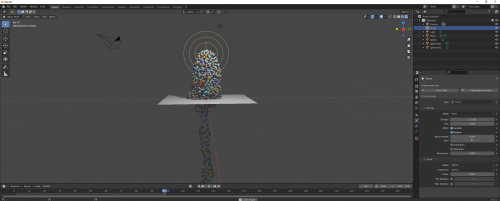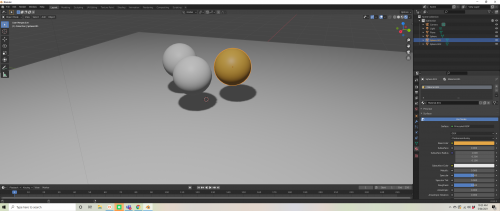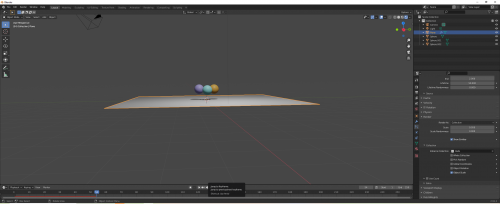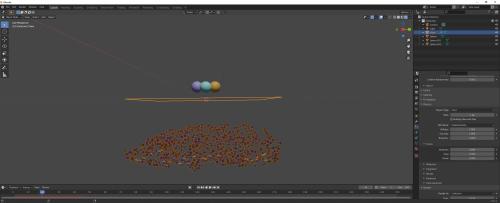Theme
Play and Forces
Context
Continuing on my Pleasure Principle journey I decided to explore the element of Discovery through play for this week’s exercise. “Discovery is the pleasure participants get from making a discovery or working something out. For example, participants may be unsure about the relationship between their actions and a sound that a work emits and may then feel pleasure when they realize that a specific action can control that sound.” Simplifying that idea and considering my other goal which is learning a small portion of a software that I’m not really familiar, with I finally decided to use Blender to make my response. But how can I add the Discovery element to it?
Luckily Blender has this option called Force Fields that lets you apply different forces and get real time renders. This can be quite interesting, as it’s hard an almost impossible to apply as many forces as possible to objects in real life. Now that I have the simulated option, I would like to treat this week’s project like a Physics Experiment and write a report on my observations or discoveries.
Method
For this week I will explore the basics of using particles with forcefields in Blender.
Response
I watched a couple of tutorials which taught me create a scene and play with most of the forcefields in Blender, this helped me develop an understanding of the particle systems and forcefields.
Here is my report:
Force fields offer a way to influence the simulation, they work with all types of physics including particles, fluid, smoke, fire, rigid, bodies soft bodies, cloth simulations and even dynamic paint.
There is a set of common settings for the force fields, first on is the shape value, which sets the direction of the force. Second one is empty objects that can only use the point and the plane types but if using a mesh for the force field it can be set to surface, every face on that mesh emits a force. Strength of course is how strong the force field will affect the simulation. This can also be set to a negative value and that will give the opposite effect. For example, if you have the force type enabled and you set it to a negative value instead of pushing objects away it will bring them closer.
The flow value defines how quickly the force will be converted into a constant airflow velocity in other words it will make the particles eventually move at the same speed, if the flow is off the particles will continuously gain velocity as they get higher. This is because the wind is constantly being applied, whereas if the flow is turned on it will actually slow down the particles until they are moving at a constant rate rather than continually gaining speed.
The noise amount will give the wind some randomness and change up how it looks. The seed controls the noise pattern of that randomness. The absorption allows collision objects to absorb some of that force in the collision object. The wind factor is how much strength is reduced when an object is parallel to a surface. If this is off it will just slide across the plane without any problems but with it turned on it will actually have resistance on the plane itself.
Falloff allows control, for example, when the force field fall off at a certain distance the shape of the fall off can be controlled and the different options will give some really cool results, with the Z direction you can either have it fall off in the positive Z or negative Z or both.
When the force field will no longer affect the stimulation the power option is kind of a mix between the minimum and maximum values. The higher the number, the closer the particles to the minimum, the lower the power the more pushed away the particles are (max distance). The radial settings underneath is for the size of the shape whatever is outside the radios will not have an effect on the force fields and of course the power is the mix between those different values.
That was my basic understanding of the force field. But I would like to be more particular about each and every one of them. The force is the simplest forcefield of them all! It adds a constant force from the centre of the object’s origin. Positive values will push particles away and negative values will bring them closer. The wind forcefield is also pretty easy to understand it will add a constant force in the direction that is pointed at. Vortex will spin the particles around. Positive values will have the particles go in a counterclockwise direction and negative values will go in a clockwise direction.
The magnetic force filed would add a magnetic force to the particles, like a gravitational pull. The harmonic or shield will attract particles to the shape that is set to. If it is set to the point option for the shape it'll bring the particles to the origin point, whereas if it's set to surface and you apply it to a mesh it will bring the particles to the surface of the mesh.
The charge forcefield deals with positive and negative charges, for this the two fields need to be activated, if both of them are positive or negative values for the strength, they will separate from each other. If one is positive and the other one is negative the particles will come together.
The turbulence force field will create a noise pattern for the force fields and give particles a lot of randomness there is also another value right here called size and this controls the size of the noise. When its set to 0 the pattern is pretty small but if you were to drag the size all the way up as high as you can go up to 10 the noise pattern will be a lot bigger if the flow value is set to 0 and the size is also set to 0 the particles will just spread out randomly and without any sort of pattern but if you bring the flow up to a value of about 3.00 or so the particles will kind of a bunch together and create some really interesting results.
The turbulence also deals with coordinates if global is turned off it will disregard the location up the turbulence and create the noise pattern based on the origin of the world. The drag force field allows a little bit of air drag be added to the particles. There are two different values, the linear and quadratic and they both do very similar things if both of them are set to zero it will have no effect in the particles, they will just fall down if the linear is set up to two and that's the highest you can go it will slow down the particles and act like there is a little bit of wind drag. The quadratic is very similar to the linear except it deals with the square of the velocity rather than just the velocity itself if both of these values are set to two it will slow down even more if the linear is set to 0 and the quadratic is set up to two it does slow down a little bit but not as much as the linear.
Reflection
My purpose for this exercise was to experiment with every single force field in Blender and I ended up having different outcomes with changing different variables as anticipated. I assumed that such simple framework for this week’s project wouldn’t really lead to a satisfying experience, but I can confidently say I was mistaken. Being able to change the different types of forces and being able to see the result in real time was really fun (maybe in a nerdy way). But I don’t believe that every person that participates in this play would feel the same. I had the Discovery pleasure due to the fact that I have never worked with forcefields before, so it had the unfamiliarity element to it. Participants who are familiar with the program might not think the same. Something else that was important was the real time render factor. If I wasn’t able to see the results immediately this play would have not been interesting.
Now that I’m familiar with force fields and what they can do I would be interested to make a game out of it. I can put a hoop and use force fields to throw as many balls in the hoop as possible. But I guess for the purpose of discovery this exercise has done alright, but there is definitely room for improvement.
References
Costello, Brigid, and Ernest Edmonds. “A Study in Play, Pleasure and Interaction Design.” Proceedings of the 2007 Conference on Designing Pleasurable Products and Interfaces. ACM, 2007. 76–91. Web.
About This Work
By Bycharlotte
Email Bycharlotte
Published On: 05/04/2021



